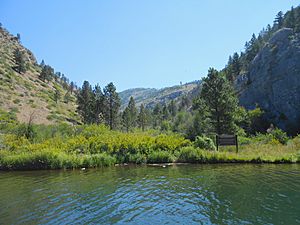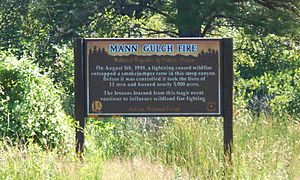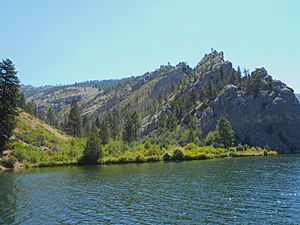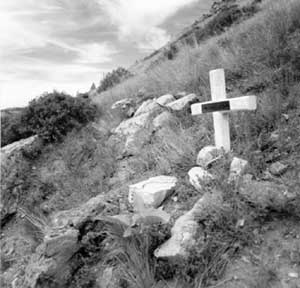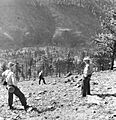Mann Gulch fire facts for kids
Quick facts for kids |
|
|
Mann Gulch Wildfire Historic District
|
|

Investigators stand on the steep, now barren, north slope of Mann Gulch.
|
|
| Lua error in Module:Location_map at line 420: attempt to index field 'wikibase' (a nil value). | |
| Nearest city | Helena, Montana |
|---|---|
| Area | 1,195 acres (484 ha) |
| Built | 1949 |
| NRHP reference No. | 99000596 |
| Added to NRHP | May 19, 1999 |
The Mann Gulch fire was a large wildfire that started on August 5, 1949. It happened in a deep valley, called a gulch, near the Missouri River in Montana. This area is now known as the Gates of the Mountains Wilderness.
A team of 15 specially trained firefighters, called smokejumpers, parachuted into the area to fight the fire. They met a fire guard who was already there. But strong, unexpected winds made the fire grow very quickly. It trapped the firefighters, forcing them to run uphill. In just ten minutes, the fire exploded, burning over 3,000 acres (1,200 ha). This tragic event killed 13 firefighters, including 12 of the smokejumpers. Only three smokejumpers survived. The fire continued to burn for five more days before it was finally put out.
After this disaster, the United States Forest Service learned many important lessons. They created new training methods and safety rules for fighting wildfires. They also started to focus more on studying fire behavior.
The Mann Gulch fire site was made a historic district on May 19, 1999. It is now listed on the National Register of Historic Places.
How the Fire Started
The Mann Gulch fire began when lightning struck the south side of the gulch. This area is part of the Gates of the Mountains, a canyon with tall cliffs. The famous explorers Lewis and Clark named this place in 1805.
A forest ranger named James O. Harrison first saw the fire around noon on August 5, 1949. Harrison was a college student working as a fire prevention guard for the summer. He had been a smokejumper before, but had stopped because it was too dangerous. He fought the fire by himself for four hours. Then, a crew of smokejumpers arrived from Missoula, Montana, in a Douglas DC-3 airplane.
Why the Fire Was So Dangerous
Several things made the Mann Gulch fire so deadly. These factors are explained in the book Young Men and Fire by Norman Maclean.
- Steep Slope: The north side of Mann Gulch was very steep, about a 75% incline. Fire spreads much faster uphill, and it's very hard to run away on such a steep slope.
- Dry Fuel: The area had a lot of dry grass, especially a type called cheatgrass. This grass burns very easily and quickly. The land had not been grazed by cattle, so there was even more dry grass.
- Team Leadership: The smokejumper foreman, R. Wagner "Wag" Dodge, didn't know most of his crew well. This might have made it harder for the crew to trust his decisions, especially when he set an "escape fire."
- Broken Radio: The crew's only radio broke when its parachute failed. This meant they couldn't talk to others for help or get important updates about the fire.
- Bad Weather: The summer was very dry, and that day was extremely hot. Strong winds blew up the gulch, pushing the fire in the same direction the men were trying to run.
The Smokejumper Plane
The C-47/DC-3 airplane, named "Miss Montana," was the only plane available for smokejumpers on August 5, 1949. It could carry 16 jumpers and their gear. Even though more help was needed, fire leaders decided not to wait for another plane. They sent "Miss Montana" out on its own. This plane was used by Johnson Flying Service to drop smokejumpers and for other jobs.
The Fire's "Blow Up"
When foreman Wag Dodge reached his men, the fire had already crossed the gulch. The intense heat and wind pushed the flames quickly up the north slope. This caused what firefighters call a "blow up," where the fire grows very fast and violently.
The firefighters couldn't see what was happening further down the gulch because of the hills. They kept moving towards the fire at first. When Dodge finally saw the danger, he turned his men around and told them to run uphill. He then ordered them to drop their heavy tools like Pulaskis and shovels. Some men dropped their tools, but others kept them, even though it slowed them down.
The fire was moving extremely fast up the steep slope. Dodge realized they couldn't outrun it. With the fire less than 100 yards behind him, he quickly lit a match and set fire to the grass in front of them. This was an escape fire. He hoped to burn an area where he and his crew could lie down safely. The main fire would then burn around them.
Dodge told three men near him, Robert Sallee, Walter Rumsey, and Eldon Diettert, to follow him into the burned area. But they misunderstood and ran straight up the ridge instead. Sallee later said he didn't know what Dodge was doing. As the rest of the crew came up, Dodge tried to get them into his escape fire. But they raced past him, hoping to get over the ridge to safety. None of the men trying to outrun the fire entered the area Dodge had burned.
What Happened Next
Four men reached the ridge top. Only two, Bob Sallee and Walter Rumsey, found a narrow crack in the rocks and escaped to the other side. They found a rock slide with no plants and waited there for the fire to pass.
William Hellman and Joseph Sylvia were caught by the fire on the ridge. They were badly burned. They survived the fire itself but died in the hospital the next day. Wag Dodge survived by lying in the charred center of the escape fire he had built.
In the book Young Men and Fire, it was said that Dodge was lifted off the ground by the fire. However, Dodge himself later said that there were "three extreme gusts of hot air that almost lifted me from the ground."
After the tragedy, 450 men fought for five more days to control the fire. It had spread to 4,500 acres.
Firefighter Casualties
Thirteen firefighters died in the Mann Gulch fire. Eleven were killed directly by the fire, and two died later from their severe burns. Only three of the sixteen smokejumpers survived.
Smokejumpers Who Died
- Robert J. Bennett, age 22, from Paris, Tennessee
- Eldon E. Diettert, age 19, from Moscow, Idaho (died on his 19th birthday)
- James O. Harrison, age 20, from Missoula, Montana (Helena National Forest Fire Guard)
- William J. Hellman, age 24, from Kalispell, Montana
- Philip R. McVey, age 22, from Babb, Montana
- David R. Navon, age 28, from Modesto, California
- Leonard L. Piper, age 23, from Blairsville, Pennsylvania
- Stanley J. Reba, from Brooklyn, New York
- Marvin L. Sherman, age 21, from Missoula, Montana
- Joseph B. Sylvia, age 24, from Plymouth, Massachusetts
- Henry J. Thol, Jr., age 19, from Kalispell, Montana
- Newton R. Thompson, age 23, from Alhambra, California
- Silas R. Thompson, age 21, from Charlotte, North Carolina
Smokejumpers Who Survived
- R. Wagner (Wag) Dodge, age 33. He was the Missoula Smokejumper foreman. Dodge died five years later from Hodgkin lymphoma.
- Walter B. Rumsey, age 21, from Larned, Kansas. Rumsey died in an airplane crash in 1980 at age 52.
- Robert W. Sallee, age 17, from Willow Creek, Montana. He was the youngest on the crew and the last survivor. He died in 2014 at age 82.
Lessons Learned
The Mann Gulch fire greatly changed how firefighters are trained. Two important safety rules were created: the "Ten Standard Firefighting Orders" and "Eighteen Situations That Shout Watch Out." Safety training became required for all firefighters.
However, these rules were not always enough. Similar tragedies happened again in the 1990 Dude fire and the 1994 South Canyon Fire. After these fires, a new safety procedure called LCES was developed. LCES stands for:
- Lookouts: Having people watching for danger.
- Communication: All firefighters having radios to talk to lookouts.
- Escape routes: Knowing safe paths to get away from the fire.
- Safety zones: Having safe places to go if trapped.
Everyone on a fire crew must understand and follow LCES.
Memorials
Thirteen crosses were put up at Mann Gulch to mark where each firefighter died. However, one of the smokejumpers, David Navon, was Jewish. In 2001, his cross was replaced with a marker showing a Star of David.
The airplane "Miss Montana," which carried the smokejumpers, is now on display at the Museum of Mountain Flying in Missoula. It was restored to honor the firefighters who died. In 2019, "Miss Montana" flew over Mann Gulch again on the 70th anniversary of the fire, dropping wreaths for the 13 men lost.
The Fire in Media
The Mann Gulch fire is the main topic of Norman Maclean's book Young Men and Fire. This book won an award in 1992.
Norman Maclean's son, John, also wrote about the fire in his 2003 book Fire and Ashes: On the Front Lines Battling Wildfires. He also wrote an article about Bob Sallee, the last survivor of the fire.
Folk Songs
The Mann Gulch fire has inspired several folk songs. James Keelaghan wrote "Cold Missouri Waters" after reading Young Men and Fire. This song has been covered by many artists. It tells the story from the perspective of foreman Wag Dodge, as he thinks about his decision to set the escape fire.
Another song, "The Mann Gulch," was written by Ross Brown. The Black Irish Band also has songs about the fire on their album "Into the Fire."
Fire Timeline
The most intense part of the Mann Gulch fire happened very quickly. Studies show that the fire burned 3,000 acres in just 10 minutes during its "blow-up" stage. This was about an hour and 45 minutes after the smokejumpers arrived.
- 4:10 PM: All the smokejumpers parachuted from the plane.
- 5:00 PM: The scattered equipment was gathered.
- 5:45 PM: The crew saw the fire coming up the north slope and started to run.
- 5:56 PM: The fire swept over the men. The exact time was known because James Harrison's pocket-watch melted from the intense heat, stopping forever at 5:56 PM.
Images for kids


